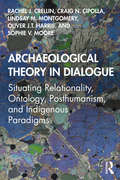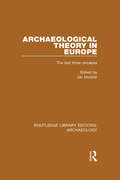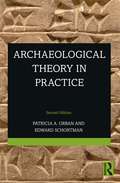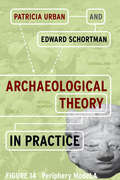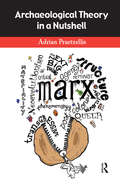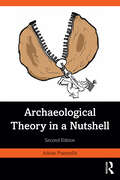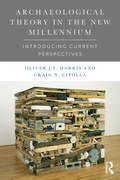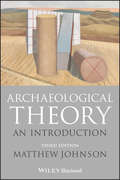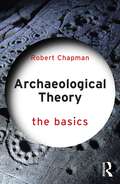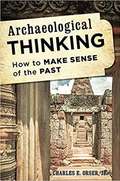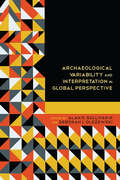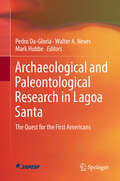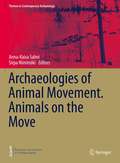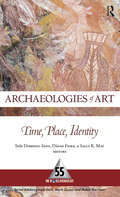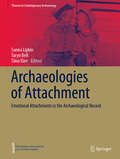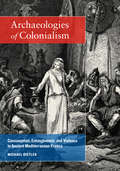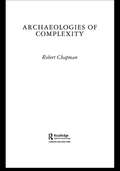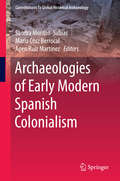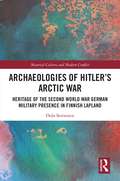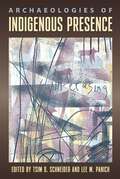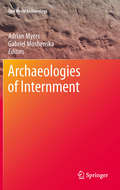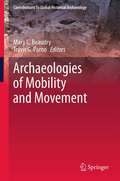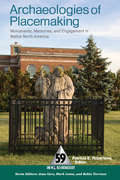- Table View
- List View
Archaeological Theory in Dialogue: Situating Relationality, Ontology, Posthumanism, and Indigenous Paradigms
by Rachel J. Crellin Craig N. Cipolla Lindsay M. Montgomery Oliver J.T. Harris Sophie V. MooreArchaeological Theory in Dialogue presents an innovative conversation between five scholars from different backgrounds on a range of central issues facing archaeology today. Interspersing detailed investigations of critical theoretical issues with dialogues between the authors, the book interrogates the importance of four themes at the heart of much contemporary theoretical debate: relations, ontology, posthumanism, and Indigenous paradigms. The authors, who work in Europe and North America, explore how these themes are shaping the ways that archaeologists conduct fieldwork, conceptualize the past, and engage with the political and ethical challenges that our discipline faces in the twenty-first century. The unique style of Archaeological Theory in Dialogue, switching between detailed arguments and dialogical exchange, makes it essential reading for both scholars and students of archaeological theory and those with an interest in the politics and ethics of the past.
Archaeological Theory in Europe: The Last Three Decades (Routledge Library Editions: Archaeology)
by Ian HodderThe 1980s witnessed exciting developments in theoretical writing in Western archaeology. Where previous decades were dominated by the Anglo-American perspective, or "New Archaeology", the recent years showed the European debate grow in confidence and vitality. This book, published in 1991, captures this spirit of debate as contributors from a wide cross-section of countries evaluate the development of the distinctly national and European characteristics of archaeology and assess future directions. Contributors consider an extensive range of ideologies and viewpoints, stressing the fundamentally historical emphasis and social construction of European archaeology. The development of archaeological theory is traced, with specific emphasis on factors which differ from country to country. Ultimately, it argues that the most active response to archaeology is to celebrate theory within a constantly critical mode. A great insight into the development of theory.
Archaeological Theory in Practice
by Patricia A Urban Edward SchortmanMany students view archaeological theory as a subject distinct from field research. This division is reinforced by the way theory is taught, often in stand-alone courses that focus more on logic and reasoning than on the application of ideas to fieldwork. Divorcing thought from action does not convey how archaeologists go about understanding the past. This book bridges the gap between theory and practice by looking in detail at how the authors and their colleagues used theory to interpret what they found while conducting research in northwest Honduras. This is not a linear narrative. Rather, the book highlights the open-ended nature of archaeological investigations in which theories guide research whose findings may challenge these initial interpretations and lead in unexpected directions. Pursuing those novel investigations requires new theories that are themselves subject to refutation by newly gathered data. The central case study is the writers’ work in Honduras. The interrelations of fieldwork, data, theory, and interpretation are also illustrated with two long-running archaeological debates, the emergence of inequality in southern Mesopotamia and inferring the ancient meanings of Stonehenge. The book is of special interest to undergraduate Anthropology/Archaeology majors and first- and second-year graduate students, along with anyone interested in how archaeologists convert the static materials we find into dynamic histories of long-vanished people.
Archaeological Theory in Practice
by PatriciaA UrbanIn this concise, friendly textbook, Patricia Urban and Edward Schortman teach the basics of archaeological theory, making explicit the crucial link between theory and the actual conduct of archaeological research. The first half of the text addresses the general nature of theory, as well as how it is used in the social sciences and in archaeology in particular. To demonstrate the usefulness of theory, the authors draw from research at Stonehenge, Mesopotamia, and their own long-term research project in the Naco Valley of Honduras. They show how theory becomes meaningful when it is used by very real individuals to interpret equally real materials. These extended narratives exemplify the creative interaction between data and theory that shape our understanding of the past. Ideal for introductory courses in archaeological theory.
Archaeological Theory in a Nutshell
by Adrian PraetzellisAdrian Praetzellis provides a brief, readable introduction to contemporary theoretical models used in archaeology for the undergraduate or beginning graduate student. He demystifies a dozen flavors of contemporary theory for the theory-phobic reader, providing a short history of each, its application in archaeology, and an example of its use in recent work. The book: teaches about different contemporary archaeological theories including postcolonialism, neoevolutionism, materiality, and queer theoy is written in accessible language with key examples for each theory includes illustrations and cartoons by the author provides questions at the end of each chapter to facilitate discussion.
Archaeological Theory in a Nutshell
by Adrian PraetzellisThis book provides a brief, readable introduction to archaeological theory. Adrian Praetzellis demystifies a pile of tricky contemporary concepts for the theory-phobic undergraduate or beginning graduate student. This new edition adds chapters on Indigenous, cognitive, and behavioral archaeologies and now covers 15 contemporary theories from neoevolutionism to queer theory. Each chapter begins with a description of the concept, its origin and significance. Next up is an example of how an archaeologist has used the idea to understand their site, making the connection between the idea and the archaeology plain and unambiguous. Each chapter ends with discussion questions and suggestions for further reading. A glossary of postmodern discourse (including that word) concludes the book. Using plain English to clarify some of the more baffling ideas used in contemporary archaeology, this book is a vital resource for students studying archaeological theory and the discipline as a whole.
Archaeological Theory in the New Millennium: Introducing Current Perspectives
by Oliver J. Harris Craig CipollaArchaeological Theory in the New Millennium provides an account of the changing world of archaeological theory and a challenge to more traditional narratives of archaeological thought. It charts the emergence of the new emphasis on relations as well as engaging with other current theoretical trends and the thinkers archaeologists regularly employ. Bringing together different strands of global archaeological theory and placing them in dialogue, the book explores the similarities and differences between different contemporary trends in theory while also highlighting potential strengths and weaknesses of different approaches. Written in a way to maximise its accessibility, in direct contrast to many of the sources on which it draws, Archaeological Theory in the New Millennium is an essential guide to cutting-edge theory for students and for professionals wishing to reacquaint themselves with this field.
Archaeological Theory: An Introduction
by Matthew JohnsonArchaeological Theory, 2nd Edition is the most current and comprehensive introduction to the field available. Thoroughly revised and updated, this engaging text offers students an ideal entry point to the major concepts and ongoing debates in archaeological research. New edition of a popular introductory text that explores the increasing diversity of approaches to archaeological theory Features more extended coverage of 'traditional' or culture-historical archaeology Examines theory across the English-speaking world and beyond Offers greatly expanded coverage of evolutionary theory, divided into sociocultural and Darwinist approaches Includes an expanded glossary, bibliography, and useful suggestions for further readings
Archaeological Theory: An Introduction (Wiley Desktop Editions Ser.)
by Matthew JohnsonA lively and accessible introduction to themes and debates in archaeological theory for students of all levels Archaeological Theory is a relatable, accessible, reader-friendly first step into the world of theory for archaeology students. Recognizing that many students shy away from the study of theory for fear that the material is too difficult or obscure, Archaeological Theory maintains that any student can develop an understanding of theory and that a knowledge of theory will lead to better practice. As one of the leading texts for introductory courses in archaeology and archaeological theory, it has provided many students with the essential foundation for a complete education in the discipline. With a focus on clarifying the history and development of archaeological theory, this valuable text serves as a roadmap to the different schools of theory in archaeology, clarifying the foundations of these schools of thought, the relationships between them, and the ideas that distinguish each from the other. Students will also learn about the relationship between archaeology and cultural and political developments, the origins of New and ‘post-processual’ archaeology, and current issues shaping the field. Written in a clear and informal style and incorporating examples, cartoons, and dialogues, this text provides an ideal introduction for students at all levels. The revised third edition has been updated with new and revised chapters and an expanded glossary and bibliography, as well as new readings to guide further study. Engages readers with informal and easy-to-understand prose, as well as examples, cartoons, and informal dialogues Prepares students to understand complex topics and current and perennial issues in the field such as epistemology, agency, and materiality in the context of archaeological practice Discusses current developments in associated disciplines New and revised chapters on the material turn, politics and other issues, and an expanded glossary and bibliography with updated reading suggestions Offers expanded coverage of materiality, cultural-historical archaeology, evolutionary theory, and the work of scholars of diverse backgrounds and specializations Engaging and illuminating, Archaeological Theory is an indispensable resource for undergraduate and graduate students in archaeology and related disciplines.
Archaeological Theory: The Basics (The Basics)
by Robert ChapmanArchaeological Theory: The Basics is an accessible introduction to an indispensable part of what archaeologists do. The book guides the reader to an understanding of what theory is, how it works and the range of theories used in archaeology. The growth of theory and the adoption of theories drawn from both the natural and social sciences have broadened our ability to produce trustworthy knowledge about the past. This book helps readers to see the value of archaeological theory and beyond what is sometimes thought to be just the use of indigestible jargon. Key theories and concepts are introduced to the reader. Among the main questions discussed are the following: What is theory and why do we need it? What major areas of theory are, and have been, used and debated in archaeology? What do they tell us about themes including human society, evolution, culture, identity and agency? How might archaeological theory change in the future? This book is written mainly for readers new to archaeology and will help them to understand archaeological theory. It assumes no prior knowledge of archaeological theory and presents it in a selective and clear way, with case studies showing how theory is used in practice.
Archaeological Thinking: How To Make Sense Of The Past
by Charles E. OrserHow do archaeologists think? How do they use the scattered and often-fragmentary remains from the past—both historical and excavated—to create meaningful, sensible interpretations of human history? In Archaeological Thinking, Charles E. Orser Jr., provides a commonsense guide to applying critical thinking skills to archaeological questions and evidence. Rather than critiquing and debunking specific cases of pseudo-archaeology or concentrating on archaeological theory, Orser considers the basics of scientific thinking, the use of logic and analogy, the meaning and context of facts, and the evaluation of source materials. He explains, concisely and accessibly, how archaeologists use these principles to create pictures of the past and teaches students to develop the skills needed to make equally reasoned interpretations.
Archaeological Variability and Interpretation in Global Perspective
by Alan P. Sullivan III and Deborah I. OlszewskiIn Archaeological Variability and Interpretation in Global Perspective, contributors illustrate the virtues of various ecological, experimental, statistical, typological, technological, and cognitive/social approaches for understanding the origins, formation histories, and inferential potential of a wide range of archaeological phenomena. As archaeologists worldwide create theoretically inspired and methodologically robust narratives of the cultural past, their research pivots on the principle that determining the origins and histories of archaeological phenomena is essential in understanding their relevance for a variety of anthropological problems. The chapters explore how the analysis of artifact, assemblage, and site distributions at different spatial and temporal scales provides new insights into how mobility strategies affect lithic assemblage composition, what causes unstable interaction patterns in complex societies, and which factors promote a sense of “place” in landscapes of abandoned structures. In addition, several chapters illustrate how new theoretical approaches and innovative methods promote reinterpretations of the regional significance of historically important archaeological sites such as Myrtos-Pyrgos (Crete, Greece), Aztalan (Wisconsin, USA), Tabun Cave (Israel), and Casas Grandes (Chihuahua, Mexico). The studies presented in Archaeological Variability and Interpretation in Global Perspective challenge orthodoxy, raise research-worthy controversies, and develop strong inferences about the diverse evolutionary pathways of humankind using theoretical perspectives that consider both new information and preexisting archaeological data. Contributors: C. Michael Barton, Brian F. Byrd, Gerald Cadogan, Philip G. Chase, Harold L. Dibble, Matthew J. Douglass, Patricia C. Fanning, Lynne Goldstein, Simon J. Holdaway, Kathryn A. Kamp, Sam Lin, Emilia Oddo, Zeljko Rezek, Julien Riel-Salvatore, Gary O. Rollefson, Jeffrey Rosenthal, Barbara J. Roth, Sissel Schroeder, Justin I. Shiner, John C. Whittaker, David R. Wilcox
Archaeological Wood and Woodworking (Elements in Current Archaeological Tools and Techniques)
by Caroline Arbuckle MacleodWood is, and always has been, one of the most common and versatile materials for creating structures and art. It is therefore also a ubiquitous element of the archaeological record. This discussion of the study of archaeological wood introduces a number of approaches to the analysis of these organic remains, including a brief overview of wood science, factors that impact the survival of wood materials, wood anatomy, and dendrochronology. These sections are intended to help archaeologists and other interested non-specialists prepare to encounter archaeological woods, and to understand the potential scientific data that these remains could contribute to our understanding of the human past. This is followed by additional approaches from the social sciences. The study of woodworking techniques and toolmarks, combined with ethnoarchaeology and experimental archaeology, can push wood analyses further. A combination of these approaches can help to create a more holistic view of humankind's relationship to wood.
Archaeological and Paleontological Research in Lagoa Santa: The Quest for the First Americans
by Pedro Da-Gloria Walter A. Neves Mark HubbeThis groundbreaking volume presents, for the first time in English, a broad historical review of the researches carried out over 170 years in the region of Lagoa Santa, Brazil, one of the most important archaeological regions in the Americas. From the pioneering work of the Danish naturalist Peter Lund in the XIX century to the recent research on the dispersion of early humans across South America, led by Walter A. Neves and colleagues, Lagoa Santa has offered remarkable findings, the largest collections of early human skeletons in the Americas, and has contributed to the overall discussions about the settlement of the Americas. This edited volume aims to fill the lack of publications in English about Lagoa Santa and gathers representatives of all the main Brazilian institutions directly involved in the archaeological and paleontological investigations in the region, in order to provide the international scientific community a comprehensive and complete account of the researches that contributed to rewrite the history of the peopling of the Americas. The book is organized in two parts. The first consists of chapters describing each of the interventions in the region, beginning with the pioneering work of Peter Lund and culminating with the latest intervention led by Walter A. Neves and his team. The second part of the book consists of reviews of current relevant research foci in the region, such as migrations, health, mortuary rituals, paleontology, rock art and technology.
Archaeologies of Animal Movement. Animals on the Move (Themes in Contemporary Archaeology)
by Anna-Kaisa Salmi Sirpa NiinimäkiThis book presents the state-of-the art in the analysis of animal movements in the past and its implications for human societies. It also addresses the importance of animal activity and mobility for understanding past human societies and past human-animal relationships through cases studies from different periods and areas. It is the first book to focus on the archaeology of animal movement on different scales – from fine-tuned muscle movements of working animals to feeding behavior and to long-distance movements across landscapes and regions.With the recent development of fine-tuned methodologies such as stable isotope analysis and physical activity assessment, the potential to understand how animals moved about in the past has increased substantially. While the chapters in the volume utilize a wide range of archaeological methods, they are all united by an emphasis on understanding animal activity and mobility patterns as something that has a major impact on human societies and human-animal relationships. Chapters in this volume show that animal activity patterns provide information on multiple aspects of human-animal relationships, including analysis of animal management practices, transhumance, global and regional trade networks, and animal domestication. This volume is of interest to scholars working in zooarchaeology and early human societies.
Archaeologies of Art: Time, Place, and Identity (One World Archaeology, Vol 55 Ser. #55)
by Sally K. May Inés Domingo Sanz Dánae FioreThis international volume draws together key research that examines visual arts of the past and contemporary indigenous societies. Placing each art style in its temporal and geographic context, the contributors show how depictions represent social mechanisms of identity construction, and how stylistic differences in product and process serve to reinforce cultural identity. Examples stretch from the Paleolithic to contemporary world and include rock art, body art, and portable arts. Ethnographic studies of contemporary art production and use, such as among contemporary Aboriginal groups, are included to help illuminate artistic practices and meanings in the past. The volume reflects the diversity of approaches used by archaeologists to incorporate visual arts into their analysis of past cultures and should be of great value to archaeologists, anthropologists, and art historians. Sponsored by the World Archaeological Congress.
Archaeologies of Attachment: Emotional Attachments in the Archaeological Record (Themes in Contemporary Archaeology)
by Taryn Bell Sanna Lipkin Tiina VäreThis edited volume offers a new approach to the study of emotion in the past, focusing on the experience of emotional attachment. Psychological research has demonstrated that all humans are capable of forming a variety of close social and emotional attachments from cradle to grave, yet archaeology has not, to date, considered the significance of these attachments in any detail. Inspired by Bowlby’s theory of attachment, one of the key theories in developmental psychology over the last 60 years, this volume sheds light on what attachment is, how it functions, and how it has influenced human life and material culture from the Palaeolithic to the present. This volume brings together contributions from authors focusing on a variety of subjects related to attachment, from social relationships with people and animals, to places, to material culture, from the deepest reaches of prehistory to the contemporary era. It aims to improve our understanding of where and how archaeologists can look for evidence of these attachments, and in doing so, it helps us to consider how these shape our understanding of human behaviour, cognition and life more broadly. This volume is of interest to archaeologists and scholars of social attachment theory.
Archaeologies of Colonialism
by Michael DietlerThis book presents a theoretically informed, up-to-date study of interactions between indigenous peoples of Mediterranean France and Etruscan, Greek, and Roman colonists during the first millennium BC. Analyzing archaeological data and ancient texts, Michael Dietler explores these colonial encounters over six centuries, focusing on material culture, urban landscapes, economic practices, and forms of violence. He shows how selective consumption linked native societies and colonists and created transformative relationships for each. Archaeologies of Colonialism also examines the role these ancient encounters played in the formation of modern European identity, colonial ideology, and practices, enumerating the problems for archaeologists attempting to re-examine these past societies.
Archaeologies of Complexity: The Later Prehistory Of South-east Spain, Iberia And The West Mediterranean (New Studies In Archaeology Ser.)
by Robert ChapmanAn up-to-date and critical analysis of how archaeologists study past societies, Archaeologies of Complexity addresses the nature of contemporary archaeology and the study of social change, and debates the transition from perceived simple, egalitarian societies to the complex power structures and divisions of our modern world. Since the eighteenth century, archaeologists have examined complexity in terms of successive types of societies, from early bands, tribes and chiefdoms to states; through stages of social evolution, including 'savagery', 'barbarism' and 'civilisation', to the present state of complexity and inequality. Presenting a radical, alternative view of ancient state societies, the book explains the often ambiguous terms of 'complexity', 'hierarchy' and inequality' and provides a critical account of the Anglo-American research of the last forty years which has heavily influenced the subject.
Archaeologies of Early Modern Spanish Colonialism (Contributions To Global Historical Archaeology)
by Sandra Montón-Subías María Cruz Berrocal Apen Ruiz MartínezArchaeologies of Early Modern Spanish Colonialism illustrates how archaeology contributes to the knowledge of early modern Spanish colonialism and the "first globalization" of the 16th and 17th centuries. Through a range of specific case studies, this book offers a global comparative perspective on colonial processes and colonial situations, and the ways in which they were experienced by the different peoples. But we also focus on marginal "unsuccessful" colonial episodes. Thus, some of the papers deal with very brief colonial events, even "marginal" in some cases, considered "failures" by the Spanish crown or even undertook without their consent. These short events are usually overlooked by traditional historiography, which is why archaeological research is particularly important in these cases, since archaeological remains may be the only type of evidence that stands as proof of these colonial events. At the same time, it critically examines the construction of categories and discourses of colonialism, and questions the ideological underpinnings of the source material required to address such a vast issue. Accordingly, the book strikes a balance between theoretical, methodological and empirical issues, integrated to a lesser or greater extent in most of the chapters.
Archaeologies of Hitler’s Arctic War: Heritage of the Second World War German Military Presence in Finnish Lapland (Material Culture and Modern Conflict)
by Oula SeitsonenThis book discusses the archaeology and heritage of the German military presence in Finnish Lapland during the Second World War, framing this northern, overlooked WWII material legacy from the nearly forgotten Arctic front as ‘dark heritage’ – a concrete reminder of Finns siding with the Nazis – and as polluting ‘war junk’ that ruins the ‘pristine natural beauty’ of Lapland’s wilderness. The scholarship herein provides fresh perspectives to contemporary discussions on heritage perception and ownership, indigenous rights, community empowerment, relational ontologies, and the ongoing worldwide refugee crisis.
Archaeologies of Indigenous Presence
by Lee M. Panich Tsim D. SchneiderHighlighting collaborative archaeological research that centers the enduring histories of Native peoples in North AmericaChallenging narratives of Indigenous cultural loss and disappearance that are still prevalent in the archaeological study of colonization, this book highlights collaborative research and efforts to center the enduring histories of Native peoples in North America through case studies from several regions across the continent.The contributors to this volume, including Indigenous scholars and Tribal resource managers, examine different ways that archaeologists can center long-term Indigenous presence in the practices of fieldwork, laboratory analysis, scholarly communication, and public interpretation. These conversations range from ways to reframe colonial encounters in light of Indigenous persistence to the practicalities of identifying poorly documented sites dating to the late nineteenth century.In recognizing Indigenous presence in the centuries after 1492, this volume counters continued patterns of unknowing in archaeology and offers new perspectives on decolonizing the field. These essays show how this approach can help expose silenced histories, modeling research practices that acknowledge Tribes as living entities with their own rights, interests, and epistemologies.
Archaeologies of Internment (One World Archaeology)
by Gabriel Moshenska Adrian MyersThe internment of civilian and military prisoners became an increasingly common feature of conflicts in the twentieth century and into the twenty-first. Prison camps, though often hastily constructed and just as quickly destroyed, have left their marks in the archaeological record. Due to both their temporary nature and their often sensitive political contexts, places of internment present a unique challenge to archaeologists and heritage managers. As archaeologists have begun to explore the material remains of internment using a range of methods, these interdisciplinary studies have demonstrated the potential to connect individual memories and historical debates to the fragmentary material remains. Archaeologies of Internment brings together in one volume a range of methodological and theoretical approaches to this developing field. The contributions are geographically and temporally diverse, ranging from Second World War internment in Europe and the USA to prison islands of the Greek Civil War, South African labor camps, and the secret detention centers of the Argentinean Junta and the East German Stasi. These studies have powerful social, cultural, political, and emotive implications, particularly in societies in which historical narratives of oppression and genocide have themselves been suppressed. By repopulating the historical narratives with individuals and grounding them in the material remains, it is hoped that they might become, at least in some cases, archaeologies of liberation.
Archaeologies of Mobility and Movement (Contributions To Global Historical Archaeology #35)
by Mary C Beaudry Travis G. ParnoThis collection of essays in Archaeologies of Mobility and Movement draws inspiration from current archaeological interest in the movement of individuals, things, and ideas in the recent past. Movement is fundamentally concerned with the relationship(s) among time, object, person, and space. The volume argues that understanding movement in the past requires a shift away from traditional, fieldwork-based archaeological ontologies towards fluid, trajectory-based studies. Archaeology, by its very nature, locates objects frozen in space (literally in their three-dimensional matrices) at sites that are often stripped of people. An archaeology of movement must break away from this stasis and cut new pathways that trace the boundary-crossing contextuality inherent in object/person mobility. Essays in this volume build on these new approaches, confronting issues of movement from a variety of perspectives. They are divided into four sections, based on how the act of moving is framed. The groups into which these chapters are placed are not meant to be unyielding or definitive. The first section, "Objects in Motion," includes case studies that follow the paths of material culture and its interactions with groups of people. The second section of this volume, "People in Motion," features chapters that explore the shifting material traces of human mobility. Chapters in the third section of this book, "Movement through Spaces," illustrate the effects that particular spaces have on the people and objects who pass through them. Finally, there is an afterward that cohesively addresses the issue of studying movement in the recent past. At the heart of Archaeologies of Mobility and Movement is a concern with the hybridity of people and things, affordances of objects and spaces, contemporary heritage issues, and the effects of movement on archaeological subjects in the recent and contemporary past.
Archaeologies of Placemaking: Monuments, Memories, and Engagement in Native North America (One World Archaeology Ser. #59)
by Patricia E. RubertoneThis collection of original essays explores the tensions between prevailing regional and national versions of Indigenous pasts created, reified, and disseminated through monuments, and Indigenous peoples’ memories and experiences of place. The contributors ask critical questions about historic preservation and commemoration methods used by modern societies and their impact on the perception and identity of the people they supposedly remember, who are generally not consulted in the commemoration process. They discuss dichotomies of history and memory, place and displacement, public spectacle and private engagement, and reconciliation and re-appropriation of the heritage of indigenous people shown in these monuments. While the case studies deal with North American indigenous experience—from California to Virginia, and from the Southwest to New England and the Canadian Maritime—they have implications for dealings between indigenous peoples and nation states worldwide. Sponsored by the World Archaeological Congress.
